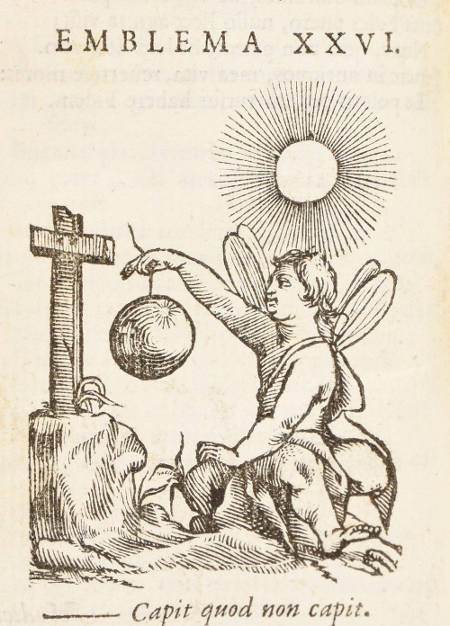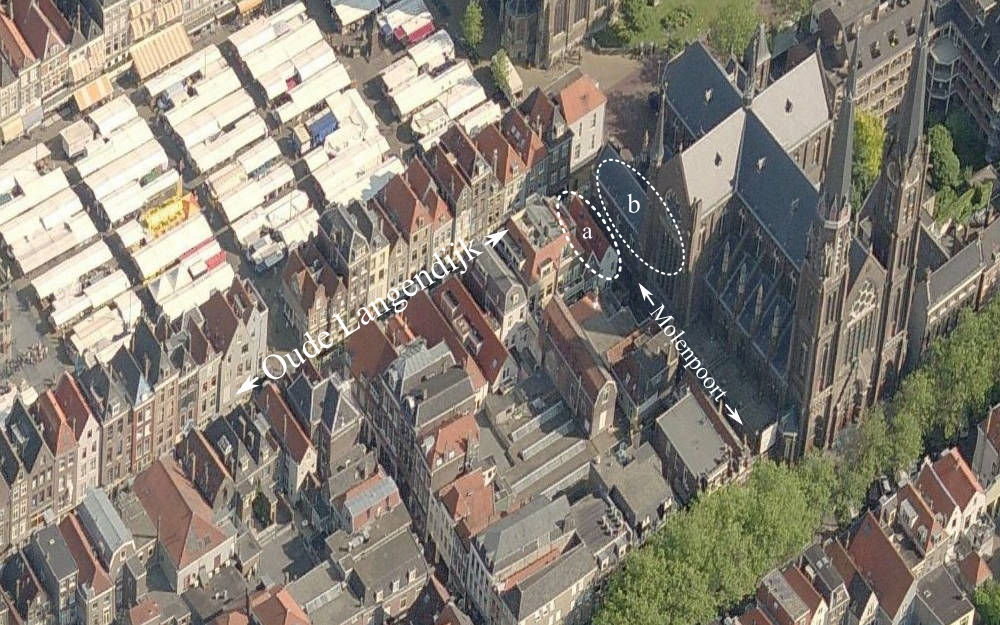There has been a long-standing debate among Vermeer scholars about whether the originally Protestant Vermeer converted to Catholicism. According to prominent scholar Gregor Weber, this was indeed the case.Pieter Roelofs and Gregor Weber, VERMEER (Rijksmuseum, Amsterdam, 2023). Vermeer's devoutly Catholic mother-in-law, Maria Thins (c. 1593–1680), insisted on his conversion before he could marry her daughter, Catharina Bolnes. Supporting this assumption is the fact that Vermeer lived at the Papenhoek (Papists' Corner) in Delft after his marriage and gave his children distinctly Catholic names, such as Maria, Franciscus, and Ignatius.

Emblemata sacra de fide, spe, charitate
S.J. Guilielmus Hessius
1636
Woodcut by J.C. Jegher, after E. Quellinus
Publisher: Antuerpiae, Ex officina Plantiniana, Balthasaris Moreti
Furthermore, when the artist took up painting in the 1650s, he created several religious works, such as Christ in the House of Mary and Martha, Allegory of Faith, and Saint Praxedes, although the authorship of the latter is still debated. To fully appreciate the rich meaning of the Allegory of Faith, one must consider the community of believers at the Papenhoek. Vermeer’s painting addresses the needs of the Catholic community in a private devotional setting, portraying the real presence of Christ on the altar and the penitent saint Mary Magdalen.
Vermeer’s work is a finely painted masterpiece that connects him to his community, family, and home. In the domestic sanctuary depicted in the Allegory of Faith, the New Testament of Christ is renewed through the holy sacrament of the altar. The opened curtain reveals an altar on which the historical Crucifixion, depicted in the painting on the back wall, is perpetually renewed in the sacrifice of the mass. The figure of faith, embodied by Mary Magdalen, personifies the enduring belief in the miracle of the altar, representing the real presence of Christ's body and blood.

Adriaen Hanneman
1661
Oil on canvas, 49 x 62 cm.
Rijksmuseum Twenthe, Amsterdam
Weber holds that Vermeer had an extensive Catholic clientele in Delft, and suspects that Jesuit priest Father Roeland de Pottere (1584–1675) (fig. 2), who may have officiated the couple's marriage, and later Isaac van der Mye, introduced Vermeer to the famed emblemata (emblem) of a glass ball of Guiliermus Hesiua (1601–1690) (fig. 1) which the artist incorporated into his Allegory of Faith, and Jesuit treatises on optics. These works presumably linked the optical device called the camera obscura to Vermeer's painting techniques. In support of his conjectures, Weber cites numerous examples from seventeenth-century books and explains how Jesuits saw light as a symbol of God. Emblems featuring optical phenomena, such as the glass sphere and the camera obscura, aimed to praise God and His creation. According to Weber, "Jesuit themes are permeated with the idea that reflected light is a reference to God's light itself, the visible sign of the invisible."
Light, of course, plays an important role in Vermeer's work, such as in The Milkmaid, which seems to emit light itself. While Weber leaves open the question of whether Vermeer actually used a camera obscura, he points out that, according to the Jesuits, the divine light falling through the lens of this device projects the image of the real world.
Acknowledging the Roman Catholic religious ambiance of Vermeer’s home and neighborhood in Papenhoek can deepen our understanding of his artistic themes, stylistic characteristics, and iconographic choices. A wealth of documents, from the initial marriage announcement in the Delft city archives to the notarized activities of his wife, mother-in-law, and children, highlights the significant role the local Roman Catholic Church played in Vermeer’s life. Although the Northern Netherlands was predominantly Protestant, the Delft Papenhoek provided a close-knit community of believers who continued to support Roman Catholicism.
Vermeer lived in this neighborhood and, while he maintained connections with religious "outsiders" such as his patron, the reputed Remonstrant Pieter Claesz. van Ruijven (1624–1674), his art—particularly his treatment of religious subjects—is closely related to Roman Catholic teachings and the interests of local adherents of this enduring faith.
It was well known that at twenty-one Vermeer married a Catholic girl from Gouda, Catharina Bolnes (c. 1631–1688). The marriage was not celebrated in Delft proper, but at a village an hour's walk away called Schipluy—today's Schipluiden—because Catholicism was entrenched there and aroused no particular comment.
The Delft Papenhoek was a virtual ghetto where the concentration of the faithful in the vicinity of the Beestenmarkt (Small-Cattle Market) and the Jesuit Church were unconcealed. Official documents from the seventeenth century refer to this area as Achter het Marktveld (behind the market square), but because the majority of its residents were Catholics, it was colloquially known as the Papenhoek, a nickname not entirely devoid of contempt among Protestants at the time. Many houses in this part of the city were owned by wealthy Catholics from Delft and its environs, which they either put at the disposal of Jesuits or rented for the benefit of their Catholic religious order.
At betrothal, it emerges, Vermeer went to live in the household on Oude Langendijk of his mother-in-law, Maria Thins, chief of the domineering women who are prominent in the life story of the painter. The exact location of this house is heatedly debated. One side beleives that it was located in a spatious house on the eastern corner of Oude Langendijk and the narrow alleyway Molenpoort—that led to Beestenmark—called Groot Serpent, while a second believes it was in a smaller house on the western corner of Oude Langendijk and Molenpoort, called Trapmolen (fig. 3).
 fig. 3 Bird's-eye-view showing part of the Papenhoek in Dleft (a. - approximate location of the Groot Serpent house| b. - approximate location of the Trapmolen house)
fig. 3 Bird's-eye-view showing part of the Papenhoek in Dleft (a. - approximate location of the Groot Serpent house| b. - approximate location of the Trapmolen house) The indominable Maria was at odds with her prosperous but irracioable brickmaker husband, Reynier Bolnes, as well as with an unbalanced and violent son. In terms of distance, the move to Oude Langendijk from the Mechelen inn, owned by the painter's father, was just a little more than 100 meters. But his marriage had transported him into a very different social milieu. Whatever the case, Johannes and Catharina’s family grew, and this seems not to have been a problem in the house There was space, and there was money. We know from seventeenth-century rolls (tax registers) that quite a lot of well-heeled people lived in Papenhoek. The same row of houses on Oude Langendijk also contained a Catholic girls’ boarding school, led by several unmarried women, where Catholic girls, mainly from well-to-do families, were educated in reading, writing, French, and handiwork. This setting exuded devotion in everything.
Even though the tension between Protestants and Catholics abated in the 1650s and 1660s, papists continued to be harassed and discriminated against. Living among themselves in the Papenhoek, Catholics may have felt more protected than hedged in. The repressed religion also contributed to the neighborhood’s solidarity. Its residents practiced their faith with great caution, individually as well as collectively. In Vermeer’s time, after all, there was less of a separation between the private and public domains in the city than today. A tightly organized community contributed to a specific social culture: residents had neighborly duties, there was much social control, and neighbors helped one another. Johannes Vermeer’s neighbors would indeed have been involved in his funeral in December 1675, as was the widespread custom in the seventeenth century. In any case, they were under no obligation to live there, and many chose not to, including Abraham de Coge, who resided on the Markt (Market Square).
Montias presimes that a schuilkerk (hidden church), run by the Jesuits, was right next door to her house; it was one of two such Catholic churches in town. But though inconspicuous, most people knew it was there, a few yards from the Nieuwe Kerk, just off the Markt. Municipal sheriffs had a way of turning a blind eye to Catholic observances, sometimes accepting "recognition money" for doing so; repression and toleration were often practiced hand in hand in a finely balanced modus vivendi. Occasionally, the Calvinist diehards complained about the growing wickedness of Popery and demanded serious action against the Catholics, and then for a time Catholics had to lie low or change their times of worship. When, in 1643, a bailiff in Rotterdam went to break up a Catholic service, he arrived too late: the congregation had met, heard Mass, and dispersed before five a.m. In Delft on one occasion in the 1650s the sheriff was condemned by vigorous Protestants such as Petrus de Witte (1622–1669) for not enforcing strict measures against the Catholics. The sheriff pointed out that the burgomasters had given the priests a license to live in the town, but to keep the complainers sweet, he told the priests to be unobtrusive in their behavior. In 1654, as already noted, special permission was given to Catholics to use the Begijnhof chapel publicly after the Donderslag; they too were Delft residents, as affected as any by the catastrophe.
It may seem strange that the Jesuits, identified with the Inquisition and the promoters of the Counter-Reformation, should have been allowed a base in a reformed town such as Delft. Actually, theirs was a schuilkerk. Worshipers had to be very discreet and were not allowed to arrive in groups, let alone in a procession. In principle, the Catholic priests permitted to operate in Delft were not supposed to belong to a religious order. The other schuilkerk in Delft, near the Oude Kerk (Old Church), was indeed under "secular" jurisdiction. Its priests, for the most part of a quietist or Jansenist persuasion, were on bad terms with the more militant Jesuits. When a priest from the Jesuit mission wished to obtain an official residence permit, he would describe himself as a secular priest, and the magistrates and burgomasters would simply turn a blind eye. This was the procedure followed when the Jesuit father Balthasar van der Beke was admitted to the town on August 10, 1663. The reasons for this tolerant attitude on the part of the municipal authorities were many. The great families of the governing classes and regents were themselves split, with one branch owing allegiance to the reformed church and another to Roman Catholicism, and the ruling Protestants were unwilling to deal too severely with their Catholic relatives. Equally, a too zealous persecution would have had an adverse effect on trade, and hence on the prosperity of the town under their regency. The manufacture of faience, begun in the late sixteenth century, had grown by the 1660s into one of Delft's principal commercial and industrial activities. Many of the great makers of Delft ware, such as Abraham de Coge and Willem Cleffius, were Catholics. Tolerance paid handsome dividends. For their two schuilkerken the Catholics were obliged to pay the municipality 2,000 guilders per year. Smaller sums of money were regularly handed over if a particular license had to be granted (for festivals or meetings held outside the town).